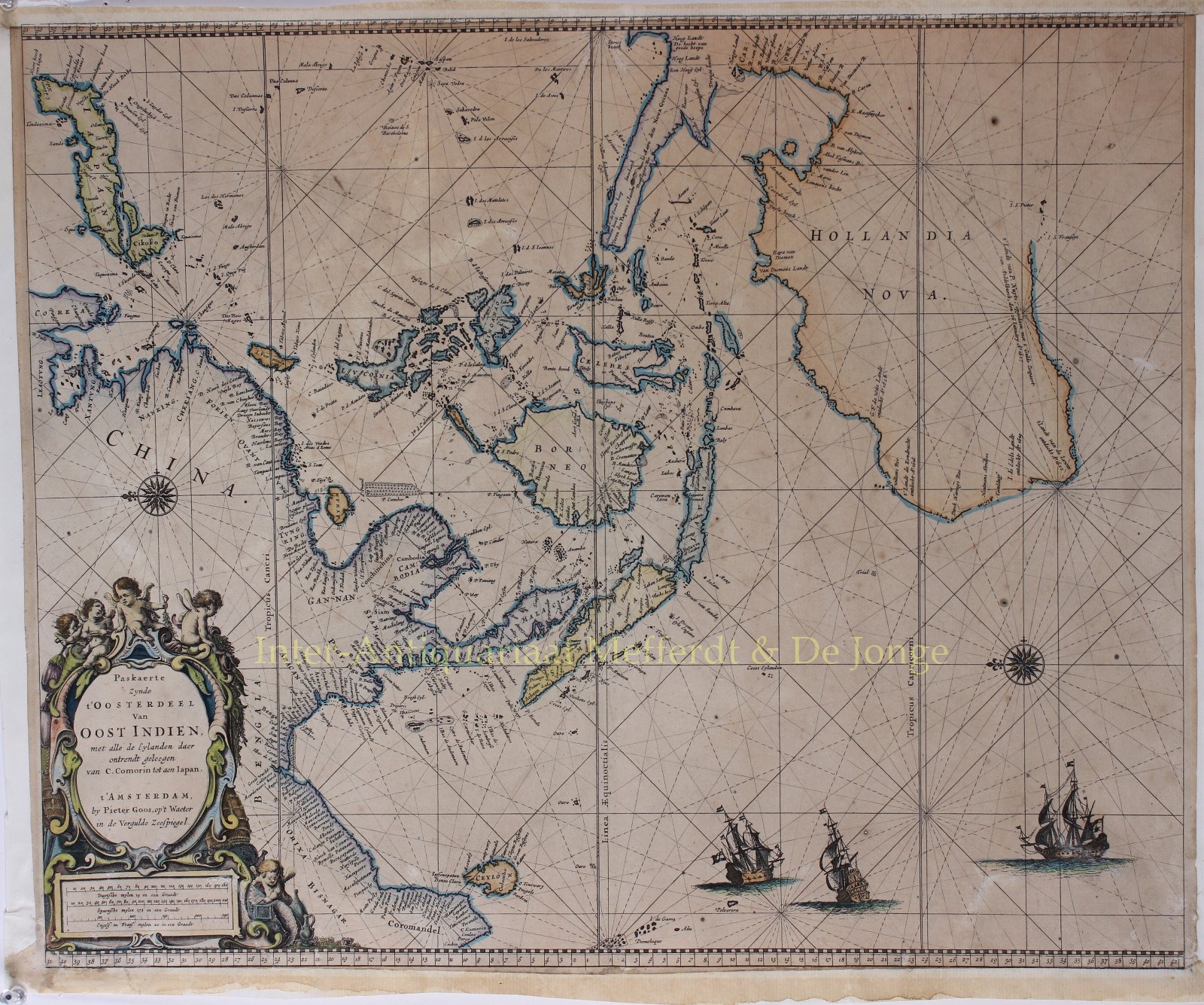East-India with Australia – Pieter Goos, 1666
MAGNIFICENT 17TH-CENTURY DUTCH SEA CHART OF THE EAST-INDIES AND AUSTRALIA “Paskaerte Zynde t’Oosterdeel Van Oost Indien, met alle de Eylanden…
Read more
MAGNIFICENT 17TH-CENTURY DUTCH SEA CHART OF THE EAST-INDIES AND AUSTRALIA
“Paskaerte Zynde t’Oosterdeel Van Oost Indien, met alle de Eylanden daer ontrendt geleegen van C. Comorin tot aen Iapan” [Sea chart of the eastern part of East-India, with all its surrounding islands from Cape Comorin to Japan]. Copper engraving by Pieter Goos published in Amsterdam in 1666. With partly original hand colouring. Size: 44,5 x 54 cm.
Magnificent Dutch sea chart published in Pieter Goos’ Zee Atlas ofte Water-Weereld, which is recognised as being one the finest Dutch sea atlases ever published. It is elegantly embellished with a beautiful title cartouche in auricular style that includes putti, three galleons, rosettes and a scale of distances. Its intended use as a sea chart is borne by the extensive use of rhumb lines and compass points.
The chart is the second of two charts encompassing the sea routes from Southern Africa to the Far East, as typically followed by ships of the Dutch East India Company in this period. As the second and easternmost sheet, the chart shows the regions from Cape Comorin (Southern India) to Japan.
Goos has north orientated to the left and Australia (“Hollandia Nova”) is shown with the Dutch discoveries, up to and including Abel Tasman’s second voyage of 1644. Other Dutch discoveries in Australia are noted and include travels by: Dirk Hartog (with his ship De Eendracht in 1616), Cornelis de Houtman in 1619, Jan Edel in 1619, the galleon Leeuwin in 1622, Jan Cartensz in 1623, Pieter Nuyts (with ‘t Gulden Zeepaert) in 1627 and Gerrit Frederikszoon de Witt (with his Vianen) in 1628. Capes and rivers in along the northern coast are named after V.O.C. governor-generals Joan Maetsuyker, Anthony van Diemen, Jan Pietersz Coen and Cornelis van der Lijn.
The map also records the first English sighting of the Australian coast and the first recorded European shipwreck off the coast of Western Australia by the Tryall, an East India Company ship under the command of John Brooke in 1622, that had run aground on the Tryal Rocks (105km off the north-west coast of Western Australia). Brooke’s subsequent untruthful report to the authorities in Batavia, had him place the rocks further west than their true position and in the direct course of V.O.C. ships sailing due north for the Sunda Straits. This new information immediately prompted Hessel Gerritsz, the V.O.C. mapmaker in Batavia, to add the rocks on Dutch charts where they remained in this incorrect position for a period of almost two hundred years.
Goos’ map served as a prototype, both in its detail and orientation, for many subsequent Dutch charts of the late 17th and early 18th Century.
The characteristic feature of Dutch charts produced in the second half of the 17th century, is that they were based solely on the results of actual observation and where that was lacking, no coastlines were shown. Goos charts and atlases were often used by mariners at sea, which resulted in many being either degraded or destroyed.
Pieter Goos (ca. 1616-1675) was a Dutch map and chart maker, whose father Abraham Goos (approx. 1590-1643) had already published numerous globes, land and sea maps together with Jodocus Hondius and Johannes Janssonius in Antwerp.
Pieter Goos gained recognition due to the publication of sea charts. He bought the copperplates of the famous pilot book for sailors, De Lichtende Columne ofte Zeespiegel (published in Amsterdam 1644, 1649, 1650), from Anthonie Jacobsz. Goos published his own editions of this work in various languages, while adding his own maps. In 1666, he published his De Zee-Atlas ofte Water-Weereld, which is considered one of the best sea atlases of its time. Goos’ sea charts came to dominate the Dutch market until the 1680s, when the Van Keulen family began to come to prominence.
Price: SOLD

